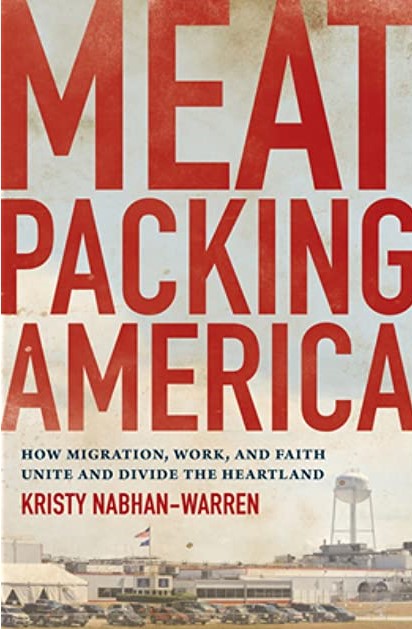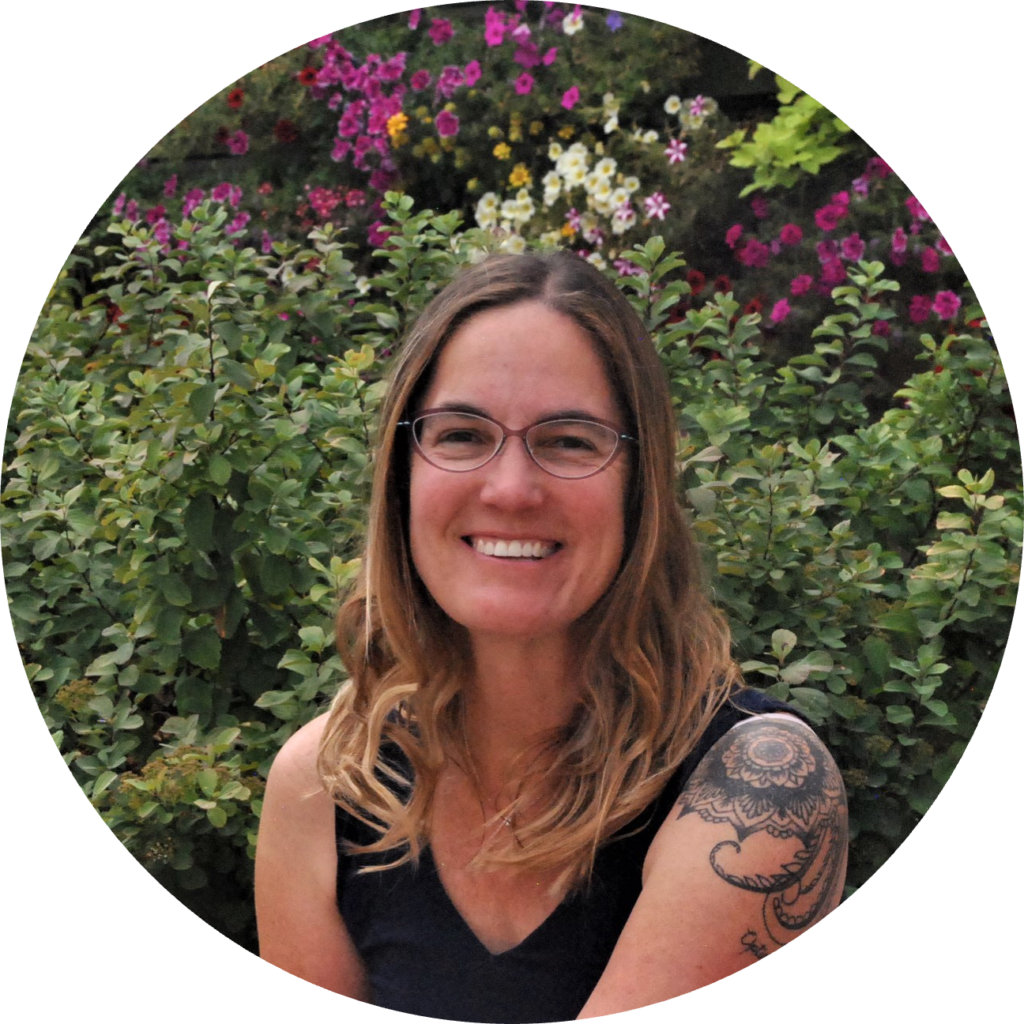
Meatpacking America: How Migration, Work, and Faith Unite and Divide the Heartland
Kristy Nabhan-Warren
An excerpt reprinted with permission from Meatpacking America: How Migration, Work, and Faith Unite and Divide the Heartland by Kristy Nabhan-Warren copyright © 2021 University of North Carolina Press.
When I first began my ethnographic fieldwork for the book that became Meatpacking America: How Migration, Work, and Faith Unite and Divide the Heartland, I did not plan to focus on today’s vertically integrated meatpacking industry in which one business owns and operates all facets of production, from insemination to feedlots to slaughterhouses. I am trained as an ethnographer of religion in the United States of the twentieth and twenty-first centuries, and my focus has long been on how people find and make spiritual and religious meaning in their everyday lives. Moreover, I have been a vegetarian for over thirty years, and let’s just say that spending time in slaughterhouses was not something I had ever considered as part of my research. But it was the fall of 2012, and I was a newly arrived professor at The University of Iowa. In my spare time, in between busy days and weeks of teaching, parenting, and making new friends, I drove around Eastern and Central Iowa, getting a feel for my new Hawkeye state. On my tour of Iowa, I passed massive tracts of monoculture farmlands, mostly corn and soybean, and saw with my own two eyes that the state was mostly rural. As someone who had studied religion in urban locales and who had lived in mostly non-rural areas, I had a lot of catching up to do, to be sure.
So as any good ethnographer would do, I read voraciously about the history of Iowa and the broader Midwest and about the place of religion, farming, and migration. And, because my new job was in part funded by an endowed chair in Catholic Studies established by lay Catholics, I felt compelled to investigate Catholicism in Iowa.
As a native Midwesterner, and interdisciplinary scholar of religion in the United States and U.S.-Mexico borderlands, I was drawn toward telling a story about Iowa as I learned that it was an increasingly popular state for secondary migration. I was also well aware of how scholars and the general public alike have long overlooked the Midwest and have seen it as a fly-over zone, backwards, even inconsequential. I know that stories are oftentimes more complicated than we think they are, and as I familiarized myself with the state, I discovered a region that was politically, ethnically, and religiously complex. It was not the caricatured white Iowa that we see depicted in the media. Midwestern states like Iowa are increasingly popular secondary migration hubs. In order to tell a more complicated story of the rural Midwest with a laser focus on Iowa, I immersed myself from 2012-2019 in conversations with farmers, cattle ranchers, priests, Iowa-born white Catholic laywomen and men, and refugees from the Northern Triangle. I conducted qualitative ethnography in several Catholic parishes in small towns such as Columbus Junction, West Liberty, and Washington. This deep dive into rural Iowa led me to the understanding that churches and religious leaders are on the frontlines of welcoming the newest waves of immigrants and refugees into their parishes and larger communities. What I also learned after conducting interviews over a four-year span was that pretty much all of the Latinos/as from Central America’s Northern Triangle who attended the parishes worked for a meatpacking plant or had worked at one at some point.
I discovered that the vulnerable humans fleeing precarity and violence in their homelands, work in rural American slaughterhouses, themselves sites of violence.
As the research for the book developed and snowballed, I learned that the most recent group of refugees and migrants work in meatpacking plants and that Congolese — and even more recently Rohingya — are recruited to work in the slaughterhouses. I discovered that the vulnerable humans fleeing precarity and violence in their homelands, work in rural American slaughterhouses, themselves sites of violence. I learned that religious faith is what keeps many of these workers hopeful for themselves and their families. Their faith in God, Jesus, Mary, Jehovah, and Allah works for them in powerful tangible and existential ways. None of the native white Iowans I interviewed in parishes and churches worked for packing plants, and white Iowans are usually in management, non-line positions at the plants. This realization was a major turning point in the research and my focus for what became the book. After conducting nearly a hundred interviews with packing plants workers, I knew that I needed to get access to packing plants, and preferably the Tyson hog processing plant where my interlocutors worked.
One of the things I share with my undergraduate and graduate students is the importance of having a clear plan for their research, but to also be poised to go in new directions if their research methods, and findings are telling them to journey to new places. Persistence is also important. I tell my students that if they have a hunch to go with that feeling. I had a feeling deep in my gut that the packing plants were necessary sites for my work, and I was right. In my conversations with meatpacking plant workers, many talked about their religious faith and how they leaned into it before, during, and after their work shifts. The Catholic Latinos/as I talked with shared that they wore rosaries and scapulars under their white Tyson smocks, and that they prayed for continued health and that they would not get injured on the job. For my Latina/o interlocutors, religious faith is what kept them going to work.

And it was my own embodied self, the embodied fieldwork that I undertook for the book, which was the connective tissue between me, the workers, and the readers of the book whom I hoped — and hope — will be moved by the stories of the refugee women and men featured in Meatpacking America. In the book’s fourth chapter, titled “The Work of God and Hogs,” I bring the reader inside the slaughterhouse:
“Walking out to a meatpacking plant floor for the first time is like stepping into an alternative reality. But this was real. Bloody real. It was loud, cold, and crimson red. There was a lot going on and it was loud. There is an intense order to the plant, and each worker has a highly repetitive yet also highly skilled task. We walked by women and men with various knives and blades cutting through the now-chilled pork meat, slicing and cutting parts that would be sold at wholesale and retail markets. Their white coats were splattered with blood. The plant was cold and constantly surveilled by USDA inspectors. Fat, meat droppings, and the occasional eyeball washed down drains next to our feet. We walked and stood amid thousands of pounds of cold flesh. As I raised my eyes to look above me, a light spray of water, mixed with hog waste, managed to enter my mouth. I knew that I should not spit it out, so I swallowed it. I can still taste, smell, and see the meat as I write this. At this particular pork processing plant, 10,000 hogs at 200 pounds apiece are killed — or, as the company prefers to say, “harvested” — and processed each day. Rows upon rows with raised teats on their underbellies — they recently nursed and unbeknownst to them weaned their piglets — moved past us, slow enough so we could take in their girth and their lifeless bodies. As we followed Dave’s path through the cold cutting floor, the hogs’ feet and hooves grazed my arms and shoulders and bumped gently into my white-coated side. They were heavy, rubbery, so heavy that I stumbled a bit at the first body brushing against me.” As an ethnographer, I have been drawn to thickly describing the worlds in which I have found myself for my research. In my first two books, I bring the reader into the sights, sounds, and smells of the religious worlds my interlocutors inhabit, from South Phoenix, Arizona to Mallorca, Spain and throughout the United States. For my third ethnographically-driven book, Meatpacking America, I wanted to balance the first-hand stories from my interlocutors with thick descriptions of packing plants. I wanted to take my readers into the hidden world of slaughterhouses and to describe them in detail. Contemporary slaughterhouses are mysterious places to most of us — hidden from plain sight as are the refugees who labor there. And the animals who are killed there are also hidden — I wanted to center them as well. As I argue in the book, both the workers who labor and animals who die there are fungible commodities. My goal in writing the book was for readers to come away with a deeper empathy for refugees and migrant workers whose labor feeds us — as well as the animals who die by for us — and also to complicate the tropes of the white Midwesterner.
I hoped that the reader would be motivated to take action, whether it was in advocating for immigration reform, safer packing plants and enforced OSHA safety policies, the unionization of meatpacking plants, more inclusive and welcoming religious communities, animal welfare organizations or greater air, soil, and water standards in communities near the plants.
The goal of empathy was coupled with my hope that the reader would take some steps and become involved in a nonprofit or to do community work with refugees or animal rights organizations. In short, I hoped that the reader would be motivated to take action, whether it was in advocating for immigration reform, safer packing plants and enforced OSHA safety policies, the unionization of meatpacking plants, more inclusive and welcoming religious communities, animal welfare organizations or greater air, soil, and water standards in communities near the plants. Researching and writing Meatpacking America was an incredible privilege as I connected with women and men who work incredibly hard for their families, and who draw on their faith traditions to survive and even thrive in their new communities. For me, the method of ethnography is as much grueling as it is humbling, and it is a deeply existential exercise. Since the publication of the book, I have recorded numerous podcasts and have given public talks, and I always note that my greatest hope is for Meatpacking America is that I hope that it serves as an example of how the humanities and social sciences can be public-facing and relevant to our times. I hope it shines a light on how scholarship can benefit the communities we write about and lead to positive change and policies that are pro-worker, pro-immigrant, and supportive of refugees. ♦

Kristy Nabhan-Warren is Associate Vice President of Research at The University of Iowa. She is Professor of Religious Studies and Gender, Women’s and Sexuality Studies and is the Figge Chair in Catholic Studies. She edits the book series Where Religion Lives with UNC Press. She is the author of Meatpacking America (UNC Press, 2021) and The Oxford Handbook of Latinx Christianities (OUP, 2022).
Recommended Citation
Nabhan-Warren, Kristy. “An excerpt from Meatpacking America: How Migration, Work, and Faith Unite and Divide the Heartland,” Canopy Forum, June 29, 2022. https://canopyforum.org/2022/06/29/an-excerpt-from-meatpacking-america-how-migration-work-and-faith-unite-and-divide-the-heartland/

